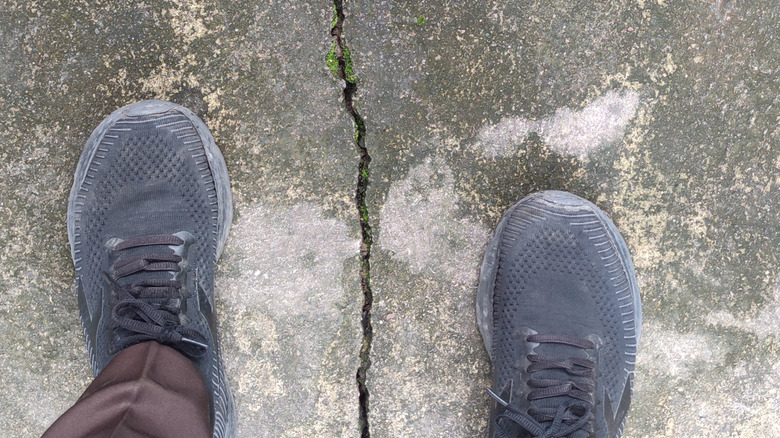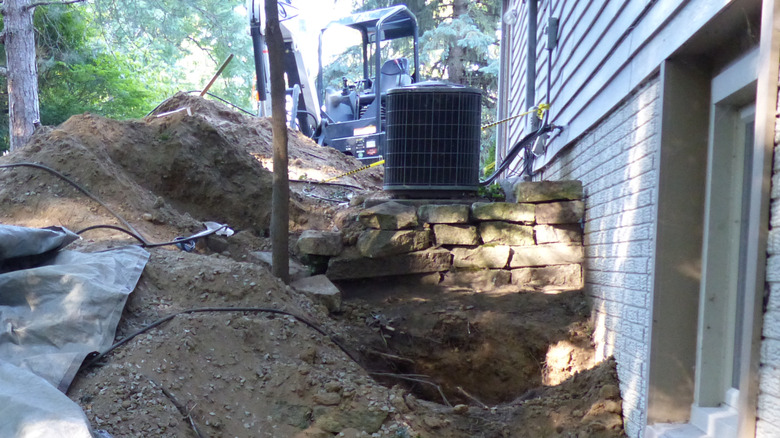Here's Why Your Garage Floor Is Cracking (And If You Should Worry)
Poor Chicken Little — scurrying around in circles and crying that the sky is falling — couldn't have begun to envision the anxiety of a homeowner convinced his house is falling (apart). The panic-driven homeowner's actions take a somewhat less aimless form, usually involving urgent calls to insurers and foundation repair companies — and the purchase of moisture meters, laser levels, and perhaps relaxation-inducing herbal teas — but it's no less hysterical. And it's often based on one simple observation, one falling acorn that bopped the homeowner in the head: There are cracks in the concrete garage floor.
The reaction is understandable. The garage floor is often the only good view people get of (what they think of as) their home's foundation. A concrete slab should be strong and stable. It's a metaphor for solidity, after all. And now there are cracks, which must surely mean the whole thing is sinking into the earth.
Of course, it's usually not. The causes of garage floor cracks can be so trivial that even home inspectors ignore them. Indeed, they're often described as inevitable, particularly in the US South. Concrete, after all, cracks very easily in the right circumstances. While it has a lot of compressive strength — that is, it holds up to being sandwiched between things like the ground and your heavy house — it can crack easily under tensile stresses from various sources (many of which are minor issues for the homeowner), as well as from weather, the properties of your particular concrete mix, and other factors. On the other hand, cracks can also be caused by serious issues like foundation problems, so you have to properly investigate.
Garage floors get cracked due to construction errors, slab settling, and more
Understanding the causes of concrete cracks involves knowing a few things about the mechanics of slab construction and movement. Many slabs are monolithic — that is, all one piece — but garage floors are often poured independently of a house's foundation walls and footings. That doesn't completely isolate the floor from foundation movement, but it does mean the garage floor isn't just a regular part of the foundation in the way people think it is. For example, a non-monolithic, independent slab is still acted upon by settling forces from the foundation wall because of outward pressures from the slab, which link the two via friction.
Now, as for the most common causes of the cracks? Those amount to construction errors. That includes slab settling, which can happen because of poor compacting of the soil, drainage problems, or simple soil erosion. Inadequate expansion joints mean your concrete floor can't go through its normal cycles of expansion and contraction. Using low-quality concrete, insufficient reinforcement, too little gravel, improper troweling of the wet concrete, and insufficient curing time are other construction-related causes. The liquid-to-solid curing transition can last decades and inevitably involves shrinkage, a common cause of cracking. Most shrinkage, however, takes place in the first 30 days after the pour.
Settling, erosion, and soil expansion usually form the more worrisome garage floor cracks. And, of course, sometimes there's more than one cause; it's possible for a crack to be caused by both the lack of an expansion joint and by soil heaving. In this way, causes can combine and make each other worse.
When to legitimately worry about a cracked garage floor (& what to do about it)
Most garage floor cracks aren't anything to worry about. Crazing, a network of light surface cracks, results from uneven drying soon after the concrete pour. Like hairline cracks, crazing is common and isn't usually a serious problem. If a crack is greater than ⅛ inch wide, is widening, is unevenly wide, or has one part of the concrete raised above the others, the cracks might represent a serious structural issue. An isolated crack might be the result of normal aging or shrinkage, but an irregular crack that stretches across the entire floor or up an adjacent wall might indicate a structural problem you need to deal with.
But what does "dealing with" a garage floor crack mean? Crazing is cosmetic, and can be managed by a homeowner via ordinary concrete floor repair like floor coating. Hairline cracks can often be stabilized and reinforced with epoxy, polyurea, or polymer concrete caulk you can apply yourself. More serious cracks, though, should be examined by a concrete repair or foundation professional. Diagnosing these problems accurately requires experience and a good working knowledge of how building systems interact with each other, calculating the load bearing of concrete, and other mysterious feats.
As for actually correcting foundation issues? That's well beyond the scope of DIY weekend projects. We're talking things like jacking up a slab (or your entire home) to make repairs. Because sudden or consistent changes in garage floor cracking can indicate serious trouble, monitor it closely until you agree on action plan with your contractors.


